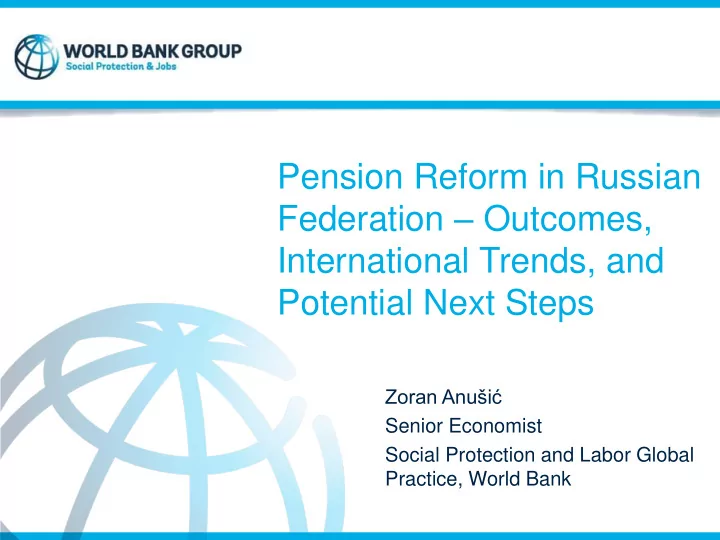

Pension Reform in Russian Federation – Outcomes, International Trends, and Potential Next Steps Zoran Anušić Senior Economist Social Protection and Labor Global Practice, World Bank
RF's 2018 pension measures not surprising ... - 2016 suspension of indexation - 2015 increase of vesting period to 15 years 2011 contribution rate increase -2018 PAYG pension increase - 2018 Retirement age increase 2 Source: FIAP, 2019
... given Russian Federation's fast aging Source: D. Pomazkin (2018) 3
Aging in RF is much faster than in EU Life expectancy improvement in Russia vs. EU -2.0 2006 2007 2008 2009 2010 2011 2012 2013 2014 2015 2016 2017 -4.0 -6.0 -8.0 years -10.0 -12.0 -14.0 Russia-EU, total Russia-EU, men Russia-EU, women -16.0 4
Improvements in life expectancy would persist Change in life expectancy at birth 2016-2035, EU and Russia 12.0 10.0 8.0 women men years 6.0 4.0 2.0 0.0 CZ EE IE EL ES IT CY LV LT LU MT NL AT PL PT SI SK SE UK NO EU* RU (high) BE BG DK DE FR HR HU RO FI RU (low) RU (mid) 5
Replacement rates, among the lowest in OECD ... 100.0 10.0 20.0 30.0 40.0 50.0 60.0 70.0 80.0 90.0 0.0 United Kingdom Mexico Poland Australia Chile Ireland Japan Slovenia Germany United States Korea New Zealand Canada Gross replacement rate, 2017, men Switzerland Norway Czech Republic Belgium Latvia Estonia OECD Greece Sweden Finland Hungary France Slovak Republic Israel Iceland Turkey Spain Portugal Luxembourg Austria Italy Denmark Netherlands South Africa Russian Federation EU28 Saudi Arabia Indonesia Brazil Argentina China India 6
... will increase in short run .... Размер средней пенсии по старости Рост пенсий в реальном выражении Источник: Минфин России Источник: Минфин России 7
... But decline in medium and long run Change in replacement rate 2017-2050 10.0 5.0 0.0 ES LV IT LT EE EL LU IE BE CZ RO CY BG PL HR RU (pre reform) 2015-35 PT SE EU* RU (reform) MID SK FR DE RU (reform) OPT MT DK FI SI AT HU -5.0 -10.0 -15.0 -20.0 -25.0 -30.0 -35.0 Sources: EU Aging Report 2018; Russia: Gorlin and Lyashok (2019) -40.0 8
Overall outcomes of 2018 reform are uncertain - Longer retirement ages would generate fiscal savings and higher pensions, - but other measures, especially pension valorisation (7%, 6.6% 6.3% in 2019, 2020 and 2021 and 5.5% in 2023 and 2024) may result in strong increase in pensions 2019-2024 and higher fiscal costs; uncertain from 2025 with regular indexation, but likely to decline steadily, - MOF and PFR project optimistic revenues with unchanged contribution rates (22% and 10% above top bracket) to finance higher PAYG costs, - It would materialize only with strong growth in activity and wages. - There is a risk of PAYG pension expansion and narrowing the fiscal space for other adequacy improving measures (like AES or reviving 2nd pillar). 9
Automatic enrollment systems around the world - AEs in operation: Australia (1992), New Zealand (2006), Italy (2007) Israel (2007), UK (2012), Canada/Quebec (2014), Turkey (2018). - AEs delayed, underway or announced: Georgia, Denmark, Poland, Ireland, Lithuania, Thailand, Germany (occupational AE going mandatory?). - Poland swapping 2nd pillar for AEs: AE starts in July 2019 (with large firms); AE rate to grow from 3.5% to 6.5% (employer+employee; Govt welcome bonus); 25% lump sum, the rest programmed withdrawals. 10
Russian Automatic Enrollment – Questions - What should be target contribution rate for AES in Russian Federation to compensate for falling adequacy? Seemingly 10%+ - Would employers and Government (or National Development Fund) participate? - What contribution rate would individuals choose? - Would the "escalator" work? - Would participants trust the system? - What would be the opt out rate? Would it be higher among the low income members? - Would the administrator work efficiently, transparently and neutrally? 11
Conclusions and possible next steps - October 2018 retirement age increase was needed given life expectancy improvements, - Pension adequacy would improve only in the short run, with higher PAYG expenditures narrowing the fiscal space, - For adequacy improvement additional pension savings and contributions seem unavoidable (10%+), through introducing Automatic Enrollment System with Government's matching and/or unfreezing 2nd pillar (moratorium until 2021). - More PAYG reforms (early retirement, reduced or subsidized contribution rates for some categories, sustainable indexation, disability assessment) are needed to improve the fiscal space for adequacy improvement. 12
Recommend
More recommend